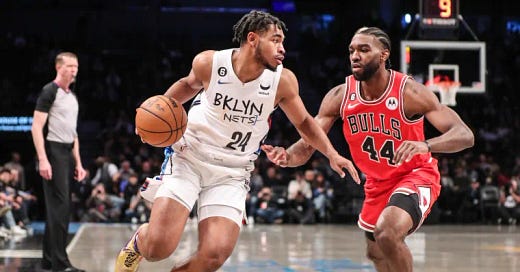For Thomas To Get The Ball In His Hands For The Nets This Season, He’ll First Have To Take It From Walker
When the Nets announced the signing of guard Lonnie Walker IV last month, my first reaction was, “Oh boy, that can’t be good for Cam Thomas.”
Despite Brooklyn’s seeming commitment to more of a youth movement this season, Thomas, who raised some eyebrows last week during a podcast when he said he would average “25 (points per game), no doubt--easy” if given the opportunity to have the ball in his hands for a full season, will be entering his third pro season facing the same uncertainties that hovered over him as when the team had more of a win-now mentality during the Kevin Durant/Kyrie Irving years. Whereas before Thomas, 21, had to frustratingly sit behind veterans like Seth Curry and Joe Harris in Brooklyn’s pecking order, he’ll now have to overcome a new obstacle in the upcoming training camp in Walker, a veteran minimum free agent acquisition with similar size and stats.
I wish I could say I like Thomas’ odds.
It’s not like Walker is past his prime—at 24, he is just three years older than Thomas. And the Nets desperately need players who can get buckets, even if it comes at positions with redundancies. Walker averaged 11.7 points in 23 minutes per game while starting 32 games for the Lakers last season. He was a valuable contributor during L.A.’s Western Conference semifinals victory over the Warriors, even playing some defense far above his reputation.
Whether or not the Nets targeted Walker because they have soured on their 2021 first-round pick (No. 27 overall) doesn’t matter. The competition for minutes should be a fascinating subplot during the preseason.
Thomas’ podcast bravado was backed up by the fact that he averaged over 26 points per game in the 15 games where he ran for at least 25 minutes last season, including four 40-point breakouts. He defies the analytics folks who dismiss the “hot hand theory.” When he gets rolling, it feels like the basket expands to the size of a dumpster. It was that way during the three-game streak of 40-plus points in February, making him the youngest NBA player to accomplish such a beastly feat.
Thomas made great strides in his three-point shooting, improving from his 27% conversion rate as a rookie to a more than respectable 38.3% last season. He also remained fearless around the basket, using his body to draw more fouls per 36 minutes than any Net other than KD last season (20 games played minimum), per NBA.com. Despite his youth, he could teach veteran Nets starting point guard Spencer Dinwiddie a few things in this regard.
However, young players by nature are often inconsistent, and there were enough 1-for-6 type outings to test Head Coach Jacque Vaughn’s patience, especially when the Nets were relatively healthy and other options were available. Thomas’ problem was that he didn’t always start cooking from the moment he stepped on the floor—he was the type of player who might need a few minutes to find a rhythm. And with the Nets fighting for a playoff spot, Vaughn didn’t have many seconds to spare.
Thomas would then go a week or more without getting any runs outside of garbage time—he finished with only 57 games played and saw less than ten minutes of action in 22 of those.
For those who dismiss Thomas as a chucker, he wasn’t all THAT inefficient last season—a shooting split of 44.1/38.3/86.8 nearly mirrors that of Portland’s Anfernee Simons, who is considered by most experts to be a far superior player.
Though Thomas’ defensive deficiencies, both on and away from the ball, have been fairly documented, I believe he’s been unjustly dinged for his allegedly poor playmaking. Every volume shooter puts up shots during a game they should regret, but I’d bet that most of Thomas’ occurred late in the shot clock. According to NBA.com, the differentiating factor in Thomas’ efficiency wasn’t whether he was pounding the rock too much before hoisting, but when he put it up. To wit:
Shooting percentages with seven seconds or more on the shot clock: 47.3% FGA/43.6% 3PFGA
Shooting percentages with under seven seconds on the shot clock: 32.7% FGA/26.3% 3PFGA
For comparison purposes, those splits were better than those for Dinwiddie following his trade to Brooklyn.
To reiterate what I wrote after last season ended ( Isolated Scoring Outbursts Wasn’t Enough For Thomas To Make Mark In Nets Rotation (substack.com) ), the underlying issue as to Thomas’ usage, or lack thereof, was that his performance last season seemed to come under the “Be wary of big numbers on a bad team” banner. For all of Thomas’ high scoring nights, he did not distinguish himself as a “winning player.” In the 15 games where he saw at least 20 minutes of action following Irving’s last appearance in a Nets uniform on February 1, which included all of his 40-point outbursts, the Nets went 3-12.
When he wasn’t playing, Thomas’ body language might not have helped his cause. You don’t want to be caught yawning by the TV cameras. From his perspective, it’s difficult to fathom why you’re sitting after showcasing such brilliance on multiple occasions. Unfortunately, that’s life in the NBA.
The Nets clearly seem open to the possibility that Thomas just needs more time—I can’t see them declining their team option for a little over $4 million for the 2024-25 season--to change the narrative through maturation and player development. Still, from an outside view, it doesn’t appear that they’re just going to “give him the ball” either.
Much to Thomas’ dismay, Brooklyn’s “microwave scoring guard off the bench” job previously filled by the departed free agent Curry looks like it will be up for grabs.



